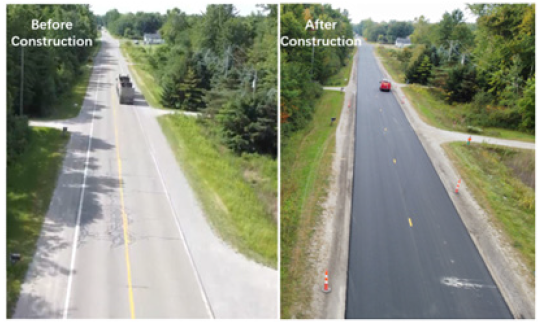- Submissions

Full Text
Polymer Science: Peer Review Journal
A Case Study of Recycled Tire Fabric and Ground Tire Rubber in Asphalt Pavement in Pavement Construction
Dongzhao Jin and Zhanping You*
Civil, Environmental, and Geospatial Engineering, Michigan Technological University, USA
*Corresponding author:Zhanping You, Civil, Environmental, and Geospatial Engineering, Michigan Technological University, 1400 Townsend Drive, Houghton, MI 49931-1295, USA
Submission: December 16, 2022;Published: December 22, 2022

ISSN: 2770-6613 Volume4 Issue4
Opinion
Figure 1:Construction schedule for this project.

Figure 2:Construction in the plant.

Non-biodegradable solid tire wastes create major environmental and public health risks [1].Therefore, it is imperative to discover an effective method to recycle tires [2]. Scrap tire rubber and fabric derived from scrap tires can be used in asphalt pavement to improve the rutting and cracking performance of the pavement [3,4]. The objective of this project is to build strong pavement with scrap tire rubber and fabric cords. The fabric includes polyester cord fabric rayon cord fabric, nylon cord fabric, and aramid cord fabric. The project is located in Smiths Creek, Michigan. A total of three field test sections with a total of 2.4km for this project were demonstrated and tested: 1). 0.8km of conventional asphalt pavement; 2). 0.8km of rubber modified asphalt pavement; 3). 0.8 km of rubber and fabric modified asphalt pavement, as shown in Figure 1. The three sections are located within the same climatic and traffic volume conditions since they are all on the same road. This creates very valuable conditions for comparing the pavement performance among conventional asphalt pavement, rubber-modified asphalt pavement, and rubber and fabric-modified asphalt pavement. The construction procedure in the plant is shown in Figure 2. Based on our mix design in the laboratory, 2 % weight of fabric and 12 % weight of rubber by the total asphalt binder’s weight was pumped into the drum from the feeder system. The pavement condition before and after construction is shown in Figure 3. The surface layer was milled and resurfaced by a new overlay.
Figure 3:Pavement condition before and after construction.

The resurfacing could help to eliminate surface distress and improve the pavement service life [5]. The rutting-cracking performance space diagram results are shown in Figure 4. Phase I means the mix has both poor rutting resistance and poor cracking resistance, and it could be used only for temporary use. Phase II means the mix has good rutting resistance but poor cracking resistance, indicating the mix’s stiffness is high and it is suitable for bottom layers. Phase III means the mix has poor rutting resistance but good cracking resistance, indicating the mix is soft and could be used as a reflective crack control layer. Phase IV means the mix has both good rutting resistance and cracking resistance, indicating the asphalt mix is expected to have excellent performance on heavy traffic roads. Therefore, the project showed that the rubber and fabric-modified asphalt pavement exhibited excellent performance both in rutting and cracking resistance.
Figure 4:Rutting-cracking performance space diagram.

Acknowledgement
The project was supported by the Scrap Tire Management Program of the Michigan Department of Environment, Great Lakes, and Energy (EGLE) and the St. Clair County Road Commission. The research team declares no conflict of interest.
References
- Jin D, Boateng AK, Chen S, Xin K, You Z (2022) Comparison of rubber asphalt with polymer asphalt under long-term aging conditions in Michigan. Sustainability 14(17): 10987.
- Jin D, Meyer TK, Chen S, Boateng KA, Pearce JM, et al. (2022) Evaluation of lab performance of stamp sand and acrylonitrile styrene acrylate waste composites without asphalt as road surface materials. Construction and Building Materials 338: 127569.
- Jin D, Ge D, Zhou X, You Z (2022) Asphalt mixture with scrap tire rubber and nylon fiber from waste tires: Laboratory performance and preliminary ME design analysis. Buildings 12(2): 160.
- Ge D, Jin D, You Z, Liu C, Yu M, et al. (2022) Laboratory performance and field case study of asphalt mixture with sasobit treated aramid fiber as modifier. Transportation Research Record 2676(2): 811-824.
- Jin D, Ge D, Chen S, Che T, Liu H, et al. (2021) Cold in-place recycling asphalt mixtures: laboratory performance and preliminary ME design analysis. Materials 14(8): 2036.
© 2022 Zhanping You. This is an open access article distributed under the terms of the Creative Commons Attribution License , which permits unrestricted use, distribution, and build upon your work non-commercially.
 a Creative Commons Attribution 4.0 International License. Based on a work at www.crimsonpublishers.com.
Best viewed in
a Creative Commons Attribution 4.0 International License. Based on a work at www.crimsonpublishers.com.
Best viewed in 







.jpg)






























 Editorial Board Registrations
Editorial Board Registrations Submit your Article
Submit your Article Refer a Friend
Refer a Friend Advertise With Us
Advertise With Us
.jpg)






.jpg)














.bmp)
.jpg)
.png)
.jpg)










.jpg)






.png)

.png)



.png)






